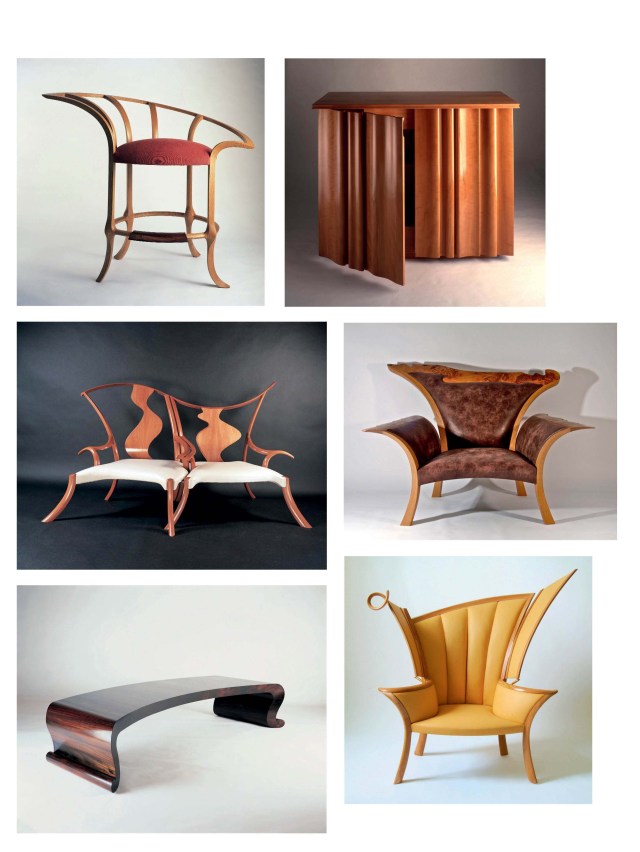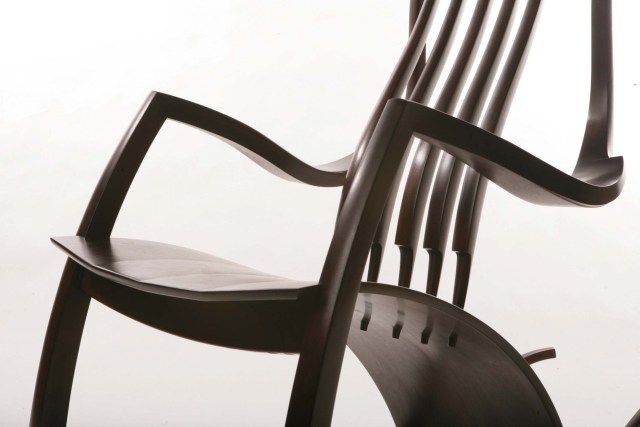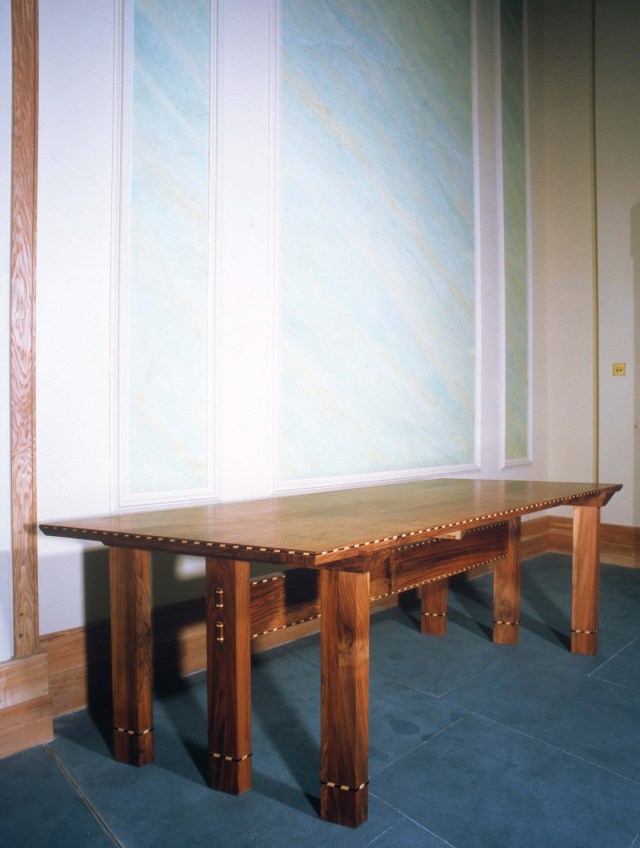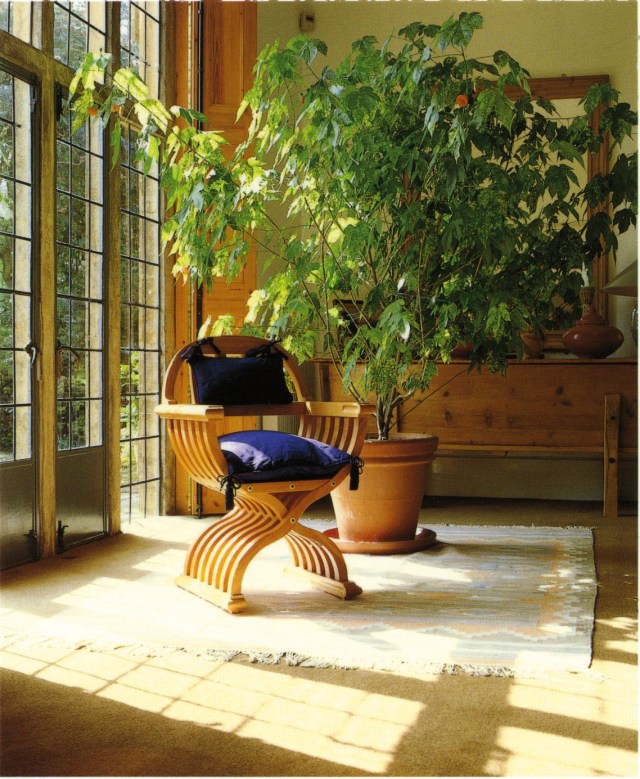
The below is excerpted from “The Intelligent Hand,” by David Savage (1948-2019), founder of Rowden Atelier School of Fine Woodworking in Devon, England.
The Bideford Workshop was a great time for me. Situated in Westcombe Lane opposite the refuse lorry park, I had 2,000 square feet of space that had been used as a metal refinishing factory. It was a horrible, stinky, dark, cheap mess. I spent weeks putting in roof lights and electrical wiring to make it as much like Alan Peter’s workshop as I could. I had little money and little paying work, but I could put my labour into making this place shine.
It’s easy for me to say now, but it’s important to work out what you will and will not do in the form of work. It’s less easy to do this with no work and little money. It’s that thing about knowing where you want to go. I said I would repair old furniture but would not do reproduction copies. I would not work in the antiques trade. I would not do fitted kitchens but I would do joinery work, doors and windows, though there seemed little chance of that. Next door were the professionals. Des and Ginger were proper joiners, not imposters like me. Ginger would strangle a 1/2″ router, cutting trenches in staircase stringers. You could hear it going from a scream to a low moan as Ginger dug it into the timber.
Des was, however, to remain a permanent reminder to us of the danger of woodworking machines. One Friday afternoon, rushing to get done, he took the top of two fingers off on the jointer. These machines are Very Patient Meat Eaters.
Two thousand square feet of space on two floors was way too big for me, I thought. I arranged to rent out the ground floor and put all my machines upstairs in what was becoming a nice, light-filled bench room with a lovely varnished solid-wood floor.
I found work soon enough making big Gothic solid-oak doors for a builder, and a regular task of assembling kitchen cabinets from flat-pack once a month. I made a small walnut bureau for a neighbour and a maple desk for a doctor in London. This was a good commission; the deal was I had made them a dining table for the cost of the timber whilst my pal was a medical student. When he qualified, I made him a desk for his office for real money. This was like being a real furniture maker.
There were disasters, as usual. (You are, I hope, beginning to expect that with me.) Des sent a local lady to me to who wanted a pair of beds. I did a lovely watercolour that sold the idea, but then couldn’t make the bed ends look like the watercolour. She wanted her money back. I learned that what you show the client in the watercolour should be pretty much what she gets. My “in laws” helped out by buying the unwanted beds from me, bless them.
Getting pieces photographed was harder than it is now. It involved a studio and a man with a huge wooden-plate camera to make 5″ x 4″ transparencies. “Dupe Trannies” (duplicated transparencies) were then sent to magazines with a 300-word “who, what, where, when” blurb. Images now are bouncing around the world in moments. Then it was different. If you had any new-looking piece, you could get it featured in a glossy magazine for nothing! And that brought more work. For several years this was my major form of marketing. Free PR was sent to magazines and published regularly. Almost no month went by without David Savage Furniture Makers being featured in one glossy magazine or another.

The most important arrivals at that time were Malcolm Vaughan and Jim Duthie. They came to me from a local maker who needed to take a break from teaching. The trouble was, this was right in the middle of the courses Jim and Malcolm were taking.
I hated the idea of students and said “no thank you” when first offered these two students. I then returned to my labours. I was assembling a pile of kitchen cabinets that a local builder wanted done by Friday. Well maybe it would be better than this….
This put me, only very recently part-baked, in the uncomfortable role of teacher. But I remembered an old saying: “In the land of the blind the one-eyed man is king.” And I attempted manfully to stay one page ahead of my very clever students.
I had a precedent to follow. Edward Barnsley had apprentices and fee-paying students. Among them was Oliver Morel, who first paid Barnsley then took a job with him as a maker after a year’s training. Morel took the model and set up a teaching workshop, first in Wales then in Morton in the Marsh. It was this model of a commercial workshop with makers, apprentices and fee-paying students that I emulated. I didn’t plan it, but it seemed to work.
The future would see this as a part of non-existent business plan. I would have a half-dozen employed makers, one or two apprentices and maybe three or four fee-paying students. The aim was to never allow the students and apprentices to outnumber the skilled makers. The advantages were cash flow and potential skill. Like Barnsley with Morel, I could find good staff amongst my students. The thing I learnt about staff is that it’s not what they know that matters, it’s who they are. After a year, you have a pretty good handle on that.
On the other side were the apprentices. I trained a number of local guys in the Bideford workshop. Two of them, Neil Harris and Chris Hayward, have become exceptional makers. Neil was my first apprentice. He was straight out of school on a Youth Opportunities Programme. I was stunned by Neil’s abilities on one of the earliest jobs I gave him: Clean the greasy parts of a disassembled veneer press I had bought. Neil and I then set about assembling the beast. We had no instructions, just an A4 photocopy of what it looked like assembled. Whilst cleaning those parts, Neil had this thing assembled in his head.
“No, that goes over there, this fits in here.” Neil Harris has gone on to become one of the best furniture makers I know. Fast, clever, efficient, he also trains spaniels to do amazing things at Field Trial Championships.
Malcolm, who stayed on as staff after his course, was also brilliant but in a different way. After his time as an executive at a paper manufacturer, Malcolm wanted to leave behind his experience with a large corporation. He brought to the workshop a wonderful sense of humour and a keen eye for business. The pine assembly bench became the boardroom table, and we each acquired corporate parking places – rank and position beyond our years. Malcolm made doing this fun. But as Malcolm was putting the briefcase away, I was getting one out. Not yet totally liberated from stammering, I had furniture to sell. It was Malcolm’s experience in public relations and his marketing wisdom that helped the place to tick more than anything.
About this time, I learned a valuable lesson about wealthy people. It began with a walnut desk that had been commissioned by a London architect friend. This was a prestige job for a building conversion in London’s Covent Garden. It was right on the Piazza – a prime spot. My desk was to fit diagonally across the reception area. Malcolm and I worked and worked to get this spot on. Table delivered, everyone delighted, craftsmen paid.
A few weeks later I get a call: “The building has been sold. The new owners don’t want your table, so it has been taken by the managing director of the developing company for his Dorset house. We suggest you get in touch with Derek’s wife, Mary.”

WHAAAAT!!!!…. I hated this. Malcolm and I had made this table for a specific place in the centre of London. Now it was going into some rich dude’s country house – a disaster I sulked over for days. It turned into something unexpected.
Getting hold of Mary Parkes was not easy, and I didn’t really want to do it. Making the phone call took me ages. When I did talk to her it was, “Oh I love your table! We are restoring a house in Dorset and we have put it there. We need some special dining furniture. Can you help us?”
I remember feeling extremely scared before I met Mary. I went trembling to a very smart address just off the Kings Road in West London. I came with some draft ideas of chairs and tables. Derek arrived later; he was genial and friendly and very much the worse for a few drinks. We settled nothing but agreed to meet at their Dorset house sometime later.
When we met again, Derek was on great form. He spent a whole morning showing me around a wonderful old house. He proudly showed me some of the restoration work. It was incredibly expensive but almost invisible. Derek took great pride and pleasure in what he was able to do to restore that beautiful old house. He introduced me to the gardeners and household staff; he knew each by name and knew about their families and children. This man was operating socially on a completely different plane to the rest of us. To me, he was amazing; I was bowled over. He liked making things, and enabling things to be made.
Mary and I worked on her ideas. Derek wanted chairs in which he “could have a great dinner party, consume a bottle of claret and not damage himself falling out of the chair.” I remember Mary doing sketches of chair backs that I recognised from chairs in the Doge’s Palace in Venice. I picked that up and developed it.

We made a table in solid English cherry and a set of chairs. It was the biggest job I had every done. I remember Malcolm and Neil sweating blood over it. Mary wanted holly and dyed blue veneer details to match her fabrics.
“We can do that,” I said with complete conviction and total ignorance. We would find a way.
We delivered the pieces, the bill was paid and the client was happy. I brought over my photographer, John Gollop, to take a shot of the pieces in location. John did that, then did something that was to me extraordinary. He picked up a chair, carried it into the next room and put it in front of a full-length window. There was a huge potted plant behind it. The photo he took changed everything.
Derek and Mary were happy if I made versions of their chairs. I thought I might make two or three. John’s photo and versions of it were in every glossy magazine for what seemed like months – the 1980s equivalent of going viral. It was an early confirmation of what furniture maker Garry Knox Bennett much later told me: “Dave, we are all in a giant photographic competition.”
We were making these damn chairs in various timbers for clients all over the country for the next few years. But more important, it told me that I could do this: I could talk with people, nice people, such as Mary and Derek Parkes, and come back with ideas for furniture that would make their homes better places to live. I could listen to what they wanted and translate that into an image that fitted them like a good suit of clothes.
Thankfully, I was a good listener; the stammer had taught me that. The first quality of a designer is to be a good listener, to take the brief and hear what is not always said. Then take the idea back to the workshop and make it. The making would be done without compromise; we would make as well as we could. Mary and Derek hadn’t quibbled over price; they wanted something special – something like the house they were living in, something new but worthy of the place. IKEA wouldn’t quite work here. The idea of “designing for clients” came directly from this job.
When I met Derek again nearly 30 years later, he was still at Blackdown House. His life has become a tribute to a wonderful English country house. We made another piece for the same room. I love that – do the job well enough and you will be working for a small group of clients for 40 years. They will always want you to make another piece.
— David Savage